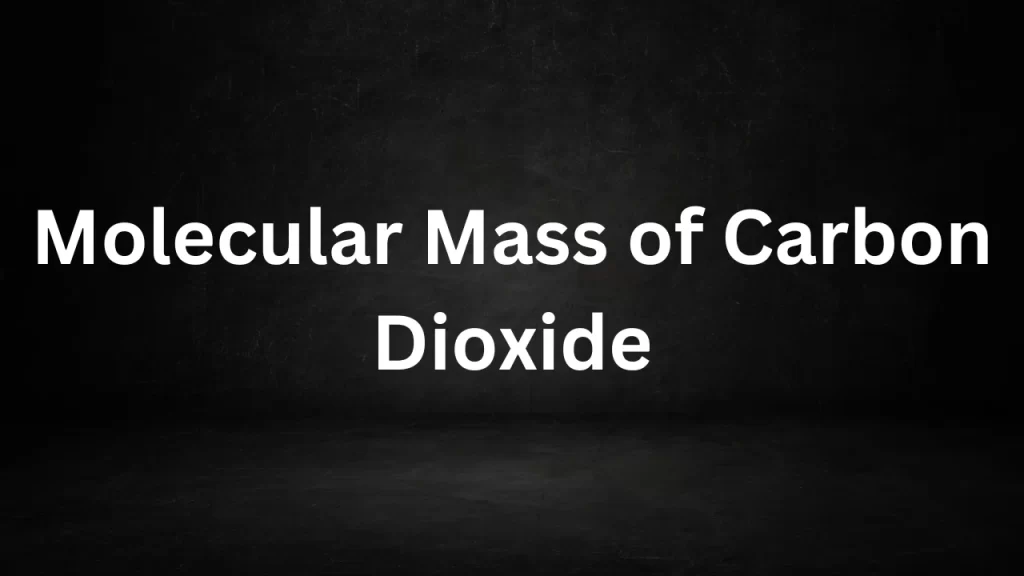Category: Class 10
Discrete Mathematics For Computer Science
Discrete Mathematics For Computer Science: Discrete mathematics forms the bedrock of computer science, providing the essential theoretical framework that underpins the development of algorithms, data structures, and problem-solving strategies.
This field of mathematics deals with distinct, countable, and separate objects, making it particularly relevant to the discrete nature of computers and digital systems. In this article, we will explore the significance of discrete mathematics in computer science, its core concepts, and its role in solving real-world computational problems.

Discrete Mathematics For Computer Science
The Significance of Discrete Mathematics in Computer Science
- Algorithm Design: Discrete mathematics is the key to designing efficient algorithms. It provides the necessary tools for analyzing and optimizing algorithms, which are fundamental to solving complex computational problems efficiently.
- Data Structures: Data structures, such as arrays, linked lists, and trees, are fundamental components of computer programs. Discrete mathematics helps in understanding the behavior and properties of these data structures, enabling programmers to choose the most suitable one for a specific task.
- Combinatorics: Combinatorics, a branch of discrete mathematics, deals with counting and arranging objects. It plays a vital role in tasks like analyzing the number of possible outcomes in a problem, which is crucial for designing algorithms and making informed decisions.
- Logic and Boolean Algebra: Discrete mathematics encompasses propositional and predicate logic, which are foundational for designing decision-making processes in computer programs. Boolean algebra is used for circuit design and logical operations.
- Graph Theory: Graphs are widely used to represent relationships between objects and are essential in various applications, including social networks, transportation systems, and network design. Discrete mathematics offers graph theory as a tool to analyze and solve problems related to networks and connectivity.
Core Concepts of Discrete Mathematics
- Sets and Set Operations: Sets are collections of distinct objects. Discrete mathematics deals with set theory, including operations like union, intersection, and complement.
- Relations and Functions: Relations describe the connections between elements in sets, while functions define mappings between them. Understanding these concepts is crucial for modeling data and processes.
- Combinatorics: Combinatorics involves counting, permutations, and combinations, which are essential for solving problems that require arranging or selecting elements from a set.
- Probability: Probability theory in discrete mathematics is used for modeling uncertainty and randomness in algorithms and decision-making processes.
- Graphs and Trees: Graph theory deals with graphs, which consist of nodes and edges, and trees, which are acyclic graphs. These structures are fundamental in computer science.
- Number Theory: Number theory explores the properties and relationships of integers, which are foundational for cryptography and data encryption.
Discrete Mathematics in Practice
The practical applications of discrete mathematics in computer science are vast and include:
- Cryptography: Discrete mathematics is fundamental in designing secure encryption and decryption algorithms to protect sensitive information in computer systems and communication.
- Artificial Intelligence: Discrete mathematics helps in designing intelligent algorithms for machine learning, pattern recognition, and natural language processing.
- Network Design: Graph theory is crucial for designing efficient communication networks, routing algorithms, and analyzing network performance.
- Database Management: Discrete mathematics is used in designing database systems, including indexing, searching, and query optimization.
- Coding Theory: It plays a significant role in error detection and correction codes, ensuring reliable data transmission and storage.
Conclusion
Discrete mathematics is the backbone of computer science, providing the theoretical foundation for algorithmic thinking and problem-solving. It equips computer scientists and programmers with the tools needed to create efficient algorithms, analyze data structures, and address real-world computational challenges. Understanding the principles of discrete mathematics is essential for anyone seeking a career in computer science and related fields, as it forms the basis of computational innovation and technological advancement.
Read More
- Molecular Mass of Carbon Dioxide
- Difference Between Conduction Convection And Radiation
- Excretory System Class 10
- Sodium Carbonate Molar Mass
- Layers Of The Earth
Frequently Aksed Questions (FAQs) On Discrete Mathematics For Computer Science
1. What is discrete mathematics, and why is it important for computer science?
Discrete mathematics is a branch of mathematics that deals with countable, distinct, and separate objects or structures. It’s crucial for computer science because it provides the theoretical foundation for algorithm design, data structure analysis, and problem-solving in computing.
2. What are some core concepts in discrete mathematics that are relevant to computer science?
- Core concepts include sets and set operations, relations and functions, combinatorics,
- robability, graph theory, number theory, logic, and Boolean algebra.
3. How does discrete mathematics relate to algorithm design?
Discrete mathematics helps in analyzing algorithms’ efficiency and correctness. Concepts like combinatorics, graph theory, and logic are essential for designing and optimizing algorithms.
4. Why is graph theory important in computer science?
Graph theory is crucial for modeling and solving problems related to networks, connectivity, and relationships between objects. It finds applications in computer networking, social networks, and transportation systems.
5. Can you provide examples of real-world applications of discrete mathematics in computer science?
Sure! Examples include cryptography for secure data transmission, graph algorithms for routing in networks, combinatorics for optimizing resource allocation, and Boolean algebra for circuit design.
Molecular Mass of Carbon Dioxide
Molecular Mass of Carbon Dioxide: Carbon dioxide (CO2) is a molecule that plays a significant role in our environment and in various industrial processes.
To comprehend its behavior and its importance in chemistry, it is essential to understand its molecular mass. In this article, we will delve into the concept of mole mass and explore the mole mass of carbon dioxide.
Molecular Mass of Carbon Dioxide
The Chemical Formula of Carbon Dioxide
The chemical formula of carbon dioxide is CO2, which signifies that one molecule of carbon dioxide consists of one carbon (C) atom and two oxygen (O) atoms.
Calculating the Molecular Mass of Carbon Dioxide
To calculate the mole mass of carbon dioxide, we need to consider the atomic masses of its constituent elements:
- Carbon (C) has an atomic mass of approximately 12.01 amu.
- Oxygen (O) has an atomic mass of approximately 16.00 amu.
Now, let’s calculate the mole mass of carbon dioxide:
mole Mass of Carbon Dioxide (CO2) = (1 x Atomic Mass of Carbon) + (2 x Atomic Mass of Oxygen) mole Mass of Carbon Dioxide = (1 x 12.01 amu) + (2 x 16.00 amu) mole Mass of Carbon Dioxide ≈ 44.01 amu
Significance of Molecular Mass in Chemistry
The mole mass of a substance is crucial for various chemical calculations, including:
- Stoichiometry: It helps in determining the quantities of reactants and products in chemical reactions.
- Mole-to-Mass Conversions: It allows converting between moles and mass, which is essential for laboratory work and chemical synthesis.
- Gas Laws: It is used in gas law equations to relate the properties of gases to their molecular masses.
Conclusion
The mole mass of carbon dioxide, approximately 44.01 atomic mass units (amu), is a fundamental parameter in understanding its properties and its role in various chemical reactions and environmental processes. Whether studying its behavior in chemical reactions or assessing its impact on the Earth’s atmosphere, knowing the mole mass of carbon dioxide is essential for a thorough understanding of its significance in chemistry and beyond.
Read More
- Difference Between Conduction Convection And Radiation
- Excretory System Class 10
- Sodium Carbonate Molar Mass
- Layers Of The Earth
- Environmental Pollution And Recycle
Frequently Asked Questions (FAQs) On Molecular Mass of Carbon Dioxide
1. What is the molecular mass of carbon dioxide?
The mole mass of carbon dioxide (CO2) is approximately 44.01 atomic mass units (amu) or unified atomic mass units (u).
2. How is molecular mass different from molar mass?
mole mass refers to the mass of a single molecule, while molar mass is the mass of one mole of a substance. For carbon dioxide, the molar mass is 44.01 grams per mole (g/mol).
3. What is the chemical formula of carbon dioxide?
The chemical formula of carbon dioxide is CO2, indicating that one molecule of carbon dioxide consists of one carbon (C) atom and two oxygen (O) atoms.
4. How is the molecular mass of carbon dioxide calculated?
To calculate the mole mass of carbon dioxide, you add the atomic masses of its constituent elements: one carbon atom and two oxygen atoms.
5. Why is knowing the molecular mass of carbon dioxide important in chemistry?
Understanding the mole mass of carbon dioxide is crucial for various chemical calculations, such as stoichiometry, mole-to-mass conversions, and its relevance in gas laws.
Difference Between Conduction Convection And Radiation
Difference Between Conduction Convection And Radiation: Heat transfer is a fundamental concept in thermodynamics and plays a crucial role in our everyday lives. There are three primary mechanisms by which heat is transferred:
conduction, convection, and radiation. Each of these processes operates differently and is responsible for heat transfer in various scenarios. In this article, we will delve into the differences between conduction, convection, and radiation to gain a better understanding of these essential principles of heat transfer.
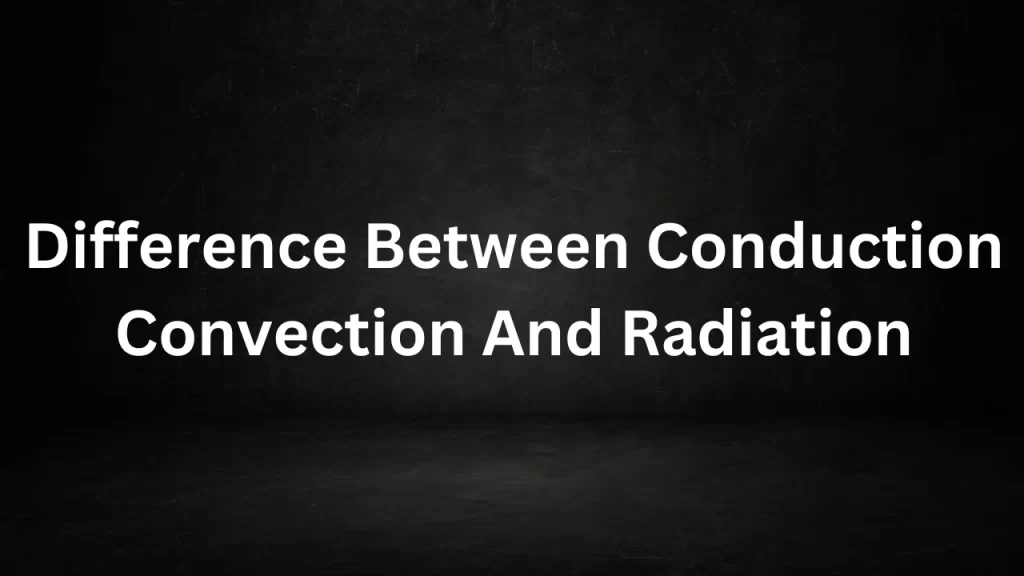 Difference Between Conduction Convection And Radiation
Difference Between Conduction Convection And Radiation
Conduction
Conduction is the process of heat transfer through direct contact between particles or objects. It occurs in solids, where heat energy is conducted from the hotter region to the colder region through the collisions between adjacent particles. Here are some key characteristics of conduction:
- Direct Contact: Conduction requires direct physical contact between the materials involved. Heat travels through the vibrations and collisions of atoms and molecules in the material.
- Materials: Solids are the primary conductors of heat. Metals, in particular, are excellent conductors due to their closely packed atomic structure.
- Rate of Transfer: The rate of heat transfer by conduction depends on the thermal conductivity of the material, the temperature difference, and the cross-sectional area through which heat flows.
- Examples: Cooking utensils on a hot stove, a metal spoon becoming hot when placed in a hot liquid, or a metal rod heating up when one end is exposed to a flame are all examples of conduction.
Convection
Convection is the process of heat transfer through the movement of fluids (liquids or gases). It occurs when a fluid with different temperatures flows, causing warmer portions to rise and cooler portions to sink. Convection can be natural or forced, and it plays a significant role in various phenomena:
- Fluid Movement: Convection requires the movement of the fluid, either naturally (due to buoyancy forces) or artificially (through fans or pumps).
- Material State: Convection occurs mainly in fluids (liquids or gases) and is less relevant in solids.
- Examples: Boiling water in a kettle, heating a room with a radiator, or the circulation of air in the Earth’s atmosphere are all examples of convection.
Radiation
Radiation is the transfer of heat energy through electromagnetic waves, such as infrared radiation. Unlike conduction and convection, radiation does not require a material medium and can occur through a vacuum. Key characteristics of radiation include:
- No Medium Required: Radiation can occur through a vacuum or through transparent materials. It does not rely on the physical contact of particles.
- Emission and Absorption: All objects emit and absorb radiation to varying degrees. Dark and rough surfaces are better at emitting and absorbing radiation than light and smooth surfaces.
- Speed of Light: Radiation travels at the speed of light, making it the fastest mode of heat transfer.
- Examples: The Sun’s heat reaching the Earth, the warmth felt when standing near a fire, and the use of infrared heaters are examples of radiation.
Conclusion
In summary, conduction, convection, and radiation are distinct mechanisms of heat transfer, each operating under different conditions and principles. Conduction occurs through direct contact in solids, convection involves the movement of fluids, and radiation relies on electromagnetic waves. Understanding these differences is essential for various applications, from cooking to designing efficient heating and cooling systems and even explaining the behavior of the Earth’s climate. These principles of heat transfer are fundamental to our comprehension of how energy is distributed and exchanged in the natural world.
Read More
- Excretory System Class 10
- Sodium Carbonate Molar Mass
- Layers Of The Earth
- Environmental Pollution And Recycle
- Batteries In Series Parallel
- Difference Between Work And Energy
Frequently Asked Questions (FAQs) On Difference Between Conduction Convection And Radiation
1. What is conduction, and how does it work?
Conduction is a method of heat transfer that occurs through direct contact between particles or objects. It involves the transfer of kinetic energy between particles in a solid material through vibrations and collisions.
2. Can conduction occur in fluids (liquids or gases)?
While conduction is primarily associated with solids, it can also occur in fluids, but it is generally less significant in fluids compared to solids.
3. What is convection, and in what materials does it occur?
Convection is the transfer of heat through the movement of fluids (liquids or gases). It occurs primarily in fluids and involves the circulation of warmer fluid rising and cooler fluid sinking.
4. What causes natural convection?
Natural convection is driven by density differences in a fluid due to temperature variations. Warmer fluids become less dense and rise, while cooler fluids become denser and sink.
5. How is forced convection different from natural convection?
Forced convection involves the use of external mechanisms, such as fans or pumps, to actively move the fluid, while natural convection occurs spontaneously due to density differences.
Difference Between Ac And Dc Generator
Difference Between Ac And Dc Generator: Generators play a vital role in our modern world by providing electrical power in various applications, from residential homes to industrial complexes.
Two common types of generators are AC (alternating current) generators and DC (direct current) generators. While their primary purpose is the same — to produce electricity — they operate on different principles and have distinct advantages and disadvantages. In this article, we will delve into the differences between AC and DC generators to help you better understand how they work and where they are used.

Difference Between Ac And Dc Generator
AC Generators
1. Operation Principle:
- AC generators, also known as alternators, operate on the principle of electromagnetic induction. When a coil of wire is rotated within a magnetic field, it induces an alternating current (AC) in the coil.
2. Output Type:
- AC generators produce alternating current, which periodically changes direction. The voltage and current values alternate between positive and negative values.
3. Voltage Regulation:
- AC generators can be designed to produce a relatively stable output voltage. Voltage regulation is achieved by adjusting the magnetic field strength or controlling the rotational speed of the generator.
4. Applications:
- AC generators are widely used for electricity generation in power plants, homes, and commercial buildings.
- They are preferred for long-distance power transmission because transformers can easily change the voltage of AC electricity, reducing losses during transmission.
DC Generators
1. Operation Principle:
- DC generators, also known as dynamos, operate on the principle of Faraday’s law of electromagnetic induction. They use a commutator and brushes to convert mechanical energy into direct current (DC).
2. Output Type:
- DC generators produce a constant, unidirectional flow of current. The voltage remains constant in polarity and magnitude.
3. Voltage Regulation:
- DC generators are known for providing a relatively stable output voltage, especially when used in conjunction with voltage regulators.
4. Applications:
- DC generators are less common in modern applications compared to AC generators.
- They were historically used in early electrical systems, such as street lighting, but have largely been replaced by AC generators.
Key Differences
1. Type of Current:
- The most fundamental difference is the type of current they produce. AC generators generate alternating current, while DC generators produce direct current.
2. Voltage Regulation:
- AC generators can be easily designed for voltage regulation, making them suitable for most power generation and distribution applications.
- DC generators also offer good voltage regulation but have become less prevalent due to the advantages of AC power distribution.
3. Use Cases:
- AC generators are the primary choice for electricity generation and distribution in the modern world.
- DC generators have limited applications today and are mainly found in specialized industries and historical installations.
4. Advantages of AC Generators:
- Versatility: AC generators can produce various voltages and frequencies to match specific requirements, making them suitable for a wide range of applications.
- Easy Transformation: AC voltage can be easily transformed using transformers, allowing for efficient long-distance power transmission.
- Availability: AC power is readily available from the electrical grid in most regions, simplifying the integration of AC generators into existing infrastructure.
5. Disadvantages of AC Generators:
- Complexity: AC generators often involve more complex control systems to regulate voltage and frequency.
- Limited DC Output: Generating direct current (DC) from an AC generator requires additional components, such as rectifiers.
6. Advantages of DC Generators:
- Constant Voltage: DC generators provide a constant voltage output, which can be advantageous for certain applications, such as battery charging.
- No Frequency Variation: DC generators do not have frequency variations like AC generators.
7. Disadvantages of DC Generators:
- Limited Applications: DC generators have a more limited range of applications in modern times due to the widespread use of AC power.
- Efficiency: AC generators are generally more efficient in large-scale power generation and distribution systems.
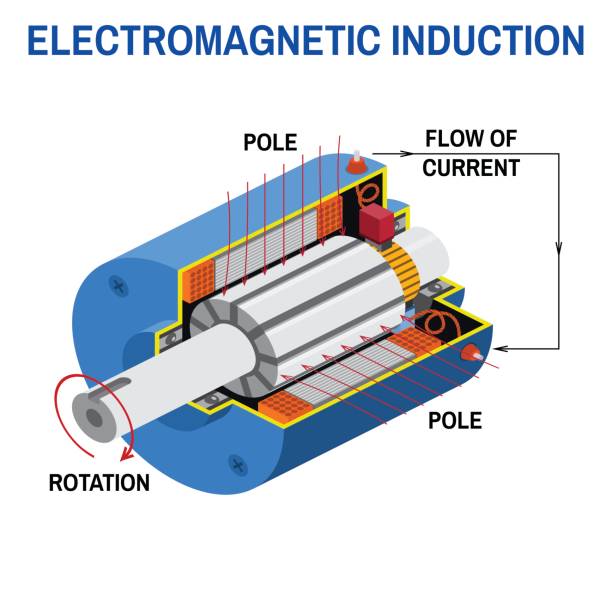

Modern electrical systems overwhelmingly favor AC power generation and distribution due to its efficiency, ease of transformation, and widespread adoption. However, DC generators still find use in specialized applications where a constant voltage or unidirectional current is required, such as in battery charging systems and certain industrial processes.
It’s important to note that advancements in power electronics and semiconductor technology have allowed for the efficient conversion of AC to DC and vice versa. This has further blurred the lines between AC and DC applications, as many devices now utilize both types of current through rectifiers and inverters.
Conclusion
AC generators and DC generators have distinct operating principles and applications. While AC generators are the backbone of modern electrical systems, DC generators continue to serve specific niches. The choice between AC and DC power generation depends on the specific needs of the application and the advantages each system offers. As technology continues to evolve, the boundaries between these two systems may continue to blur, resulting in more flexible and efficient power generation and distribution solutions.
Read More
- Excretory System Class 10
- Sodium Carbonate Molar Mass
- Layers Of The Earth
- Environmental Pollution And Recycle
- Batteries In Series Parallel
Frequently Asked Questions (FAQs) On Difference Between Ac And Dc Generator
1. What is the fundamental difference between AC and DC generators?
The primary difference lies in the type of current they produce. AC generators generate alternating current that periodically changes direction, while DC generators produce direct current with a constant flow in one direction.
2. How do AC generators work?
AC generators operate on the principle of electromagnetic induction. When a coil of wire rotates within a magnetic field, it induces an alternating current (AC) in the coil.
3. How do DC generators work?
DC generators, or dynamos, work based on Faraday’s law of electromagnetic induction. They use a commutator and brushes to convert mechanical energy into direct current (DC).
4. Which type of generator is more commonly used today?
AC generators are more commonly used in modern applications, especially for power generation and distribution, due to their efficiency and ease of voltage regulation.
5. What are the advantages of AC generators?
- AC generators are versatile, as they can produce various voltages and frequencies to match specific needs.
- They allow for efficient long-distance power transmission through transformers.
- AC power is readily available from the electrical grid in most regions.
Excretory System Class 10
Excretory System Class 10: The excretory system is a marvel of biological engineering, playing a vital role in maintaining the body’s internal environment by eliminating waste products and regulating essential substances.
This intricate system, comprised of various organs and processes, ensures the body remains in a state of balance and optimal functioning. In this article, we will explore the excretory system’s components, functions, and its pivotal role in human physiology.

Excretory System Class 10
Components of the Excretory System
The excretory system consists of several key components, each with a specialized role:
- Kidneys: The kidneys are the primary organs of the excretory system. Humans typically have two kidneys, which are bean-shaped and located on either side of the spine. Their main function is to filter blood, remove waste products, excess ions, and excess water, and produce urine.
- Ureters: Ureters are muscular tubes that connect the kidneys to the bladder. They transport urine from the kidneys to the bladder for storage.
- Bladder: The bladder serves as a reservoir for storing urine until it is expelled from the body. It has stretchable walls that allow it to expand as it fills.
- Urethra: The urethra is a duct that connects the bladder to the external environment. It serves as the exit point for urine to leave the body.
Functions of the Excretory System
The excretory system performs several vital functions:
- Filtration: The kidneys filter blood to remove metabolic waste products, excess salts, and excess water, which are then excreted as urine.
- Regulation of Electrolytes: The excretory system helps maintain the body’s electrolyte balance by selectively reabsorbing essential ions (such as sodium, potassium, and calcium) and excreting excess ones.
- Acid-Base Balance: The system regulates the body’s pH level by controlling the secretion of hydrogen ions and bicarbonate ions into the urine.
- Blood Pressure Regulation: The kidneys play a role in regulating blood pressure by adjusting blood volume through the renin-angiotensin-aldosterone system.
- Erythropoiesis Regulation: The kidneys produce erythropoietin, a hormone that stimulates the production of red blood cells in response to low oxygen levels.
Importance of the Excretory System
The excretory system is vital for maintaining homeostasis, which is the body’s state of internal balance. By expelling waste and regulating vital substances, the excretory system upholds internal stability, crucial for cellular and organ functions. Failure of the excretory system can lead to serious health issues, such as kidney disease, electrolyte imbalances, and hypertension.
Common Excretory System Disorders
Several disorders can affect the excretory system, including:
- Kidney Stones: The formation of hard mineral deposits in the kidneys can lead to severe pain and blockage of urine flow.
- Urinary Tract Infections (UTIs): Infections in the urinary tract can affect various parts of the excretory system and cause discomfort and pain.
- Chronic Kidney Disease: A progressive loss of kidney function can result from conditions like diabetes and high blood pressure, leading to kidney failure.
- Hypertension: Kidney dysfunction can contribute to high blood pressure, which, in turn, can further damage the kidneys.
Conclusion
The excretory system is a complex and vital component of the human body, responsible for filtering waste products, maintaining electrolyte balance, regulating blood pressure, and much more. Its efficient functioning is essential for overall health and well-being. Recognizing the excretory system’s significance underscores the importance of preserving its well-being and promptly addressing any potential health concerns. It’s a remarkable system that quietly performs its duties, ensuring that our internal environment remains conducive to life.
Read More
- Sodium Carbonate Molar Mass
- Layers Of The Earth
- Environmental Pollution And Recycle
- Batteries In Series Parallel
- Difference Between Work And Energy
Frequently Asked Questions (FAQs) Excretory System Class 10
1. What is the excretory system?
The excretory system is a biological system in the human body responsible for eliminating waste products, excess substances, and maintaining a balance of essential chemicals and ions to regulate the body’s internal environment.
2. What are the main organs of the excretory system?
The main organs of the excretory system are the kidneys, ureters, bladder, and urethra.
3. What is the primary function of the kidneys in the excretory system?
The primary function of the kidneys is to filter blood, remove waste products (like urea and creatinine), regulate electrolyte balance, and produce urine.
4. How does the excretory system help maintain the body’s internal balance?
The excretory system maintains the body’s internal balance by filtering blood to remove waste products and excess substances, regulating water and electrolyte levels, and controlling the body’s pH.
5. What is the role of the ureters and bladder in the excretory system?
The ureters transport urine from the kidneys to the bladder, which serves as a temporary storage reservoir for urine until it is expelled from the body through the urethra.
Sodium Carbonate Molar Mass
Sodium Carbonate Molar Mass: Unveiling the Molecular Weight of Na2CO3 Molar mass, also known as molecular weight, is a fundamental concept in chemistry that plays a pivotal role in understanding and quantifying chemical reactions. In this article, we delve into the world of sodium carbonate (Na2CO3), a compound of significant importance in various industrial, scientific, and everyday applications, to explore its molar mass and its relevance in the realm of chemistry.

Sodium Carbonate Molar Mass
What is Molar Mass?
Molar mass is the mass of a substance expressed in grams per mole (g/mol). It represents the weight of one mole of that substance, where a mole is a unit that contains approximately 6.022 x 10^23 particles, be they atoms, molecules, ions, or any other entity. Molar mass is crucial in chemistry because it helps determine the quantity of a substance involved in a chemical reaction, making it an essential tool for stoichiometry and analytical chemistry.
Calculating the Molar Mass of Sodium Carbonate (Na2CO3)
To determine the molar mass of sodium carbonate (Na2CO3), we follow these steps:
1. Identify the elements: Sodium carbonate consists of three elements: sodium (Na), carbon (C), and oxygen (O).
2. Find the atomic masses: Consult the periodic table to find the atomic masses of each element.
- Atomic mass of Na ≈ 22.99 g/mol
- Atomic mass of C ≈ 12.01 g/mol
- Atomic mass of O ≈ 16.00 g/mol
3. Determine the number of atoms: In sodium carbonate, there are two sodium (Na) atoms, one carbon (C) atom, and three oxygen (O) atoms.
4. Multiply and sum: Calculate the molar mass by multiplying the atomic mass of each element by the number of atoms of that element in the compound and then summing these values.
- Molar Mass of Na2CO3 = (2 x Atomic Mass of Na) + (1 x Atomic Mass of C) + (3 x Atomic Mass of O)
- Molar Mass of Na2CO3 = (2 x 22.99 g/mol) + (1 x 12.01 g/mol) + (3 x 16.00 g/mol)
- Molar Mass of Na2CO3 ≈ 105.99 g/mol
Hence, the molar mass of sodium carbonate (Na2CO3) is approximately 105.99 grams per mole (g/mol).
Significance of Sodium Carbonate’s Molar Mass
Understanding the mol mass of sodium carbonate holds practical significance in several areas:
- Chemical Reactions: It is vital for determining the amount of sodium carbonate required or produced in chemical reactions, making it essential for proper dosing and yield estimation.
- Stoichiometry: Sodium carbonate’s molar mass plays a critical role in stoichiometric calculations, facilitating the precise relationship between reactants and products in chemical reactions.
- Industry Applications: Industries, including the detergent, glass, and chemical manufacturing sectors, rely on accurate molar mass values for process optimization and quality control.
- Analytical Chemistry: Mol mass information is invaluable in analytical techniques such as mass spectrometry, aiding in the identification and quantification of substances in samples.
- Household Uses: Sodium carbonate, commonly known as soda ash or washing soda, is used in various household applications, including cleaning, pH adjustment, and water softening.
To sum up, the mol mass of sodium carbonate is a fundamental factor in chemistry, allowing precise measurements and applications. In industry, research, or daily life, a solid grasp of molar mass calculations is crucial for accurate chemical analysis.
Read More
- Layers Of The Earth
- Environmental Pollution And Recycle
- Batteries In Series Parallel
- Difference Between Work And Energy
- Difference Between Concave Convex Lens
Frequently Asked Questions (FAQs) Sodium Carbonate Molar Mass
1. What is sodium carbonate, and why is its molar mass important?
Sodium carbonate, also known as soda ash or washing soda, is a chemical compound with the formula Na2CO3. Its molar mass is important because it allows us to calculate the amount of sodium carbonate in chemical reactions and solutions accurately.
2. How is the molar mass of sodium carbonate calculated?
- To find the mol mass of sodium carbonate (Na2CO3), sum the atomic masses of its elements: sodium (Na), carbon (C), and oxygen (O). The formula for calculating it is:
- Calculate the molar mass of Na2CO3 by adding: 2(Atomic Mass of Na) + Atomic Mass of C + 3(Atomic Mass of O).
3. What are the atomic masses of the elements in sodium carbonate?
- Atomic mass of Na (sodium) ≈ 22.99 grams per mole (g/mol)
- Atomic mass of C (carbon) ≈ 12.01 g/mol
- Atomic mass of O (oxygen) ≈ 16.00 g/mol
4. What is the molar mass of sodium carbonate (Na2CO3)?
The mol mass of sodium carbonate is approximately 105.99 g/mol.
5. Why is molar mass important in chemical reactions?
Molar mass is crucial for stoichiometry, a branch of chemistry that deals with the quantitative relationships between reactants and products in chemical reactions. It allows chemists to calculate the precise amounts of substances involved in reactions.
Layers Of The Earth
Layers of the Earth:The Earth, our home and a planet of immense beauty, harbors secrets beneath its surface that are as intriguing as the landscapes we see above ground. As we embark on a journey to explore the layers of the Earth, we’ll uncover the mysteries hidden beneath our feet and gain a deeper understanding of the geological forces that shape our world.

Layers Of The Earth:A Journey to the Center of Our Planet
1. The Crust: Earth’s Outer Shell
The Earth’s outermost layer is known as the crust. It’s the thinnest of all the Earth’s layers, making up just a tiny fraction of the planet’s total volume. Beneath our oceans, the crust is relatively thin, about 3 to 5 miles (5 to 8 kilometers) thick, while beneath the continents, it’s significantly thicker, ranging from 20 to 30 miles (30 to 50 kilometers). The crust is where we find the diverse landscapes, continents, and the ocean floors.
2. The Mantle: A Region of Heat and Movement
Beneath the crust lies the mantle, which extends to a depth of about 1,800 miles (2,900 kilometers). The mantle is primarily composed of solid rock, but it behaves like a slow-moving, viscous fluid over geological timescales. Convection currents in the mantle are responsible for the movement of tectonic plates on the Earth’s surface, which leads to the formation of mountains, earthquakes, and volcanoes.
3. The Outer Core: A Molten Sea of Iron and Nickel
Beneath the mantle, we encounter the outer core, a region composed of liquid iron and nickel. This molten layer is responsible for generating the Earth’s magnetic field through a process called the geodynamo effect. It extends from a depth of about 1,800 miles (2,900 kilometers) to 3,700 miles (5,950 kilometers).
4. The Inner Core: Earth’s Solid, Superheated Heart
At the Earth’s center lies the inner core, which extends from a depth of 3,700 miles (5,950 kilometers) to the very center of the planet, approximately 4,000 miles (6,400 kilometers) down. Despite the extreme pressure, the inner core is solid, primarily composed of iron and nickel, with temperatures reaching up to 9,000 degrees Fahrenheit (5,000 degrees Celsius) — hotter than the surface of the sun!
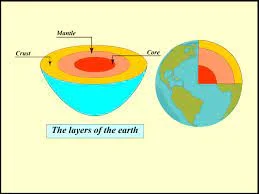
Why Do These Layers Matter?
Understanding the layers of the Earth is fundamental to comprehending the planet’s geological processes and phenomena. Here are some key reasons why these layers matter:
- Tectonic Plate Movement: The movement of tectonic plates, which float on the semi-fluid asthenosphere of the upper mantle, is responsible for earthquakes, mountain formation, and the shifting of continents.
- Magnetic Field Generation: The molten iron in the outer core generates the Earth’s magnetic field, which protects our planet from harmful solar radiation and guides migratory animals.
- Earth’s History: The study of Earth’s layers helps scientists unravel the planet’s geological history, including the formation of continents, oceans, and the evolution of life.
- Natural Resources: Knowledge of Earth’s interior aids in the exploration and extraction of valuable resources such as minerals, oil, and natural gas.
- Volcanoes and Earthquakes: The understanding of the mantle and core’s composition and behavior helps predict volcanic eruptions and seismic activity, contributing to public safety.
In conclusion, the Earth’s layers are a testament to the complexity and wonder of our planet. As we explore the depths of our world, we gain insight into the forces that have shaped its past and continue to mold its future. These layers remind us that there is still much to discover and learn about the remarkable planet we call home.
Read More
- Environmental Pollution And Recycle
- Batteries In Series Parallel
- Difference Between Work And Energy
- Difference Between Concave Convex Lens
- Difference Between Electric Field And Magnetic Field
Frequently Asked Questions (FAQs) Layers Of The Earth
1. How many layers does the Earth have, and what are they called?
The Earth has four main layers:
- Crust: The outermost layer.
- Mantle: Located beneath the crust.
- Outer Core: Lies beneath the mantle.
- Inner Core: At the Earth’s center.
2. What is the Earth’s crust made of?
The Earth’s crust is primarily composed of solid rock. It consists of a variety of minerals, including silicates, oxides, and carbonates.
3. How thick is the Earth’s crust?
The thickness of the Earth’s crust varies depending on whether it’s under the oceans or continents. Oceanic crust is relatively thin, about 3 to 5 miles (5 to 8 kilometers), while continental crust is thicker, ranging from 20 to 30 miles (30 to 50 kilometers).
4. What is the main component of the Earth’s mantle?
The Earth’s mantle is primarily composed of solid rock, mainly silicate minerals like olivine and pyroxene. It behaves like a slow-moving, viscous fluid over geological timescales.
5. How does the mantle contribute to plate tectonics?
The mantle’s convective currents are responsible for the movement of tectonic plates on the Earth’s surface. This movement leads to the formation of mountains, earthquakes, and volcanoes.
Environmental Pollution And Recycle
Environmental Pollution And Recycle: Environmental pollution poses a significant threat to the planet’s health and well-being. From air and water pollution to the accumulation of non-biodegradable waste, our activities have far-reaching consequences for the environment.
However, recycling offers a ray of hope by mitigating the impact of pollution and conserving resources. In this article, we will delve into the various forms of environmental pollution, the importance of recycling, and how recycling can help us achieve a more sustainable future.
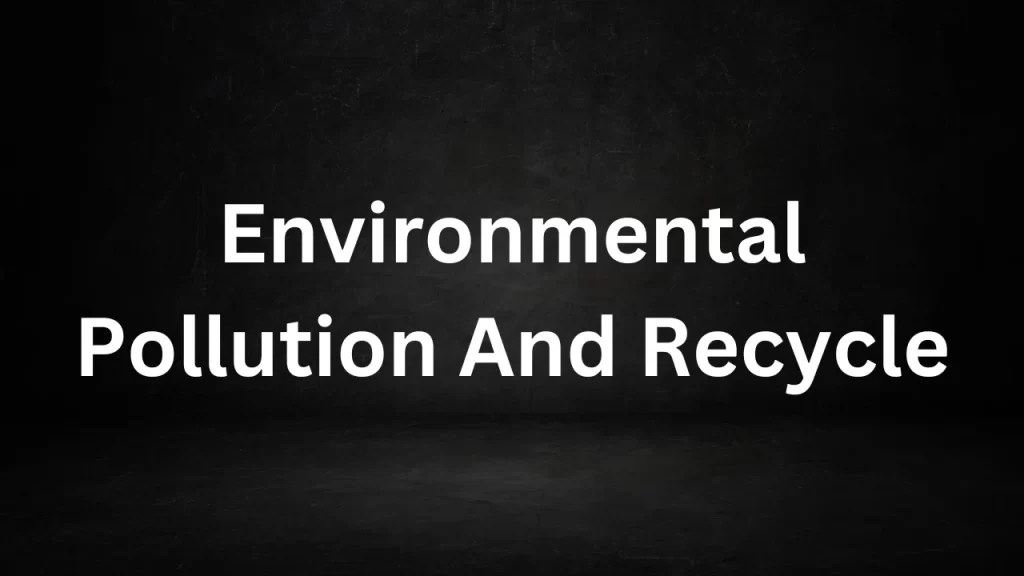
Environmental Pollution And Recycle
Understanding Environmental Pollution
- Air Pollution: This occurs when harmful substances, such as particulate matter, nitrogen oxides, and volatile organic compounds, are released into the atmosphere. Sources include industrial processes, vehicular emissions, and deforestation. Air pollution leads to respiratory diseases, climate change, and damage to ecosystems.
- Water Pollution: Contamination of water bodies, such as rivers, lakes, and oceans, by chemicals, pathogens, and heavy metals is a major concern. Agricultural runoff, industrial discharges, and improper waste disposal contribute to water pollution, harming aquatic life and affecting drinking water quality.
- Land Pollution: Land pollution results from the disposal of hazardous waste, including plastics, electronic waste (e-waste), and chemicals, on the ground. It contaminates soil and groundwater, making land unsuitable for agriculture or other productive uses.
- Noise Pollution: Excessive noise from transportation, industrial activities, and urbanization can lead to stress, hearing loss, and other health issues. It also disrupts wildlife habitats and communication among species.
The Role of Recycling in Mitigating Pollution
Recycling is a powerful tool for addressing environmental pollution and fostering sustainability:
- Reduction in Waste: Recycling diverts materials from landfills and incinerators, reducing the burden of land and air pollution. This is particularly important for items like plastics, which can persist in the environment for centuries.
- Conservation of Resources: Recycling conserves natural resources like metals, paper, and plastics. For example, recycling aluminum uses significantly less energy than producing it from raw materials, reducing greenhouse gas emissions.
- Energy Savings: The recycling process typically requires less energy than manufacturing products from raw materials. This reduces the emissions of pollutants associated with energy production, contributing to cleaner air.
- Reducing Water Pollution: Recycling reduces the need for extracting and processing virgin materials, which can lead to water pollution through industrial runoff and mining activities.
- Mitigating Climate Change: Recycling helps lower greenhouse gas emissions by decreasing the energy demand associated with resource extraction and manufacturing.
The Importance of Responsible Recycling Practices
While recycling is a vital part of environmental conservation, it’s essential to practice responsible recycling:
- Proper Disposal: Ensure that recyclables are disposed of in the correct recycling bins or centers. Contaminated recycling streams can lead to waste being sent to landfills.
- Education and Awareness: Public awareness campaigns and education about recycling practices help ensure that individuals know what can and cannot be recycled.
- Support for Recycling Programs: Advocate for and support local recycling programs and policies that promote recycling initiatives within your community.
- Reduce and Reuse: Prioritize reducing and reusing materials before recycling them. Reducing consumption is often the most effective way to minimize environmental impact.
Conclusion
Environmental pollution remains a pressing global challenge, but recycling offers a practical and effective solution. By reducing waste, conserving resources, and mitigating pollution, recycling contributes to a more sustainable future.
Individuals, communities, and governments must work together to promote responsible recycling practices, reduce waste generation, and minimize our collective impact on the environment. It is through these efforts that we can pave the way for a cleaner, healthier planet for generations to come.
Read More
- Batteries In Series Parallel
- Difference Between Work And Energy
- Difference Between Concave Convex Lens
- Difference Between Electric Field And Magnetic Field
- Difference Between Transducer And Sensor
Frequently Asked Questions (FAQs) Environmental Pollution And Recycle
1. What is environmental pollution, and why is it a concern?
Environmental pollution refers to the introduction of harmful substances or contaminants into the environment, leading to adverse effects on ecosystems, human health, and the quality of air, water, and soil. It is a concern because it can harm natural habitats, endanger species, and negatively impact human well-being.
2. How can I reduce air pollution in my daily life?
- Reduce vehicle emissions by carpooling, using public transportation, or driving fuel-efficient vehicles.
- Support clean energy sources like wind and solar power.
- Minimize the use of products that release volatile organic compounds (VOCs).
- Plant trees and promote green spaces to help filter the air.
3. What are some common sources of water pollution, and how can we prevent it?
- Common sources include industrial discharges, agricultural runoff, sewage, and improper waste disposal.
- Prevention measures include proper waste disposal, using eco-friendly products, and supporting regulations to limit industrial pollution.
4. How can individuals reduce land pollution in their daily lives?
- Practice responsible waste disposal by recycling, composting, and disposing of hazardous materials properly.
- Reduce single-use plastics and opt for reusable products.
- Support initiatives to clean up litter and polluted areas.
5. What are the benefits of recycling?
- Recycling reduces waste sent to landfills and incinerators.
- It conserves natural resources and energy.
- Recycling lowers greenhouse gas emissions.
- It contributes to a circular economy where materials are reused, reducing the need for raw material extraction.
Batteries In Series Parallel
Batteries In Series Parallel: Batteries play an integral role in our everyday lives, powering everything from our mobile devices to electric vehicles.
To meet the diverse energy needs of various applications, it is essential to understand how batteries can be connected in series and parallel configurations.
By combining batteries in these configurations, you can either increase voltage, capacity, or both, depending on your specific requirements. In this article, we will explore the concepts of connecting batteries in series and parallel and discuss the advantages and considerations associated with each method.

Batteries In Series Parallel
Batteries in Series
Connecting batteries in series involves joining the positive terminal of one battery to the negative terminal of the next battery. This arrangement increases the total voltage while keeping the capacity (mAh or Ah) constant. Here’s how it works:
- Voltage Boost: When batteries are connected in series, the voltage of each battery is added together. For instance, if you connect two 1.5-volt AA batteries in series, you will have a total voltage of 3 volts (1.5V + 1.5V).
- Same Capacity: Importantly, the overall capacity remains the same as that of a single battery. In the example above, if each AA battery had a capacity of 2000mAh, the series configuration would still have a capacity of 2000mAh.
- Applications: Series configurations are commonly used in applications that require higher voltage, such as electric vehicles, solar power systems, and certain types of flashlights.
Advantages of Batteries in Series:
- Increased voltage for higher power requirements.
- Ability to use multiple batteries with the same capacity.
- Suitable for applications where voltage is the primary concern.
Considerations:
- If one battery in the series fails, it can disrupt the entire circuit.
- Charging and discharging must be balanced to prevent overcharging or over-discharging individual batteries.
Batteries in Parallel
Connecting batteries in parallel involves joining the positive terminals of all batteries together and the negative terminals together. This configuration increases the total capacity while keeping the voltage constant. Here’s how it works:
Capacity Enhancement: When batteries are connected in parallel, the capacity of each battery is added together. For example, if you connect two 2000mAh AA batteries in parallel, you will have a total capacity of 4000mAh (2000mAh + 2000mAh).
- Same Voltage: The voltage in a parallel configuration remains the same as that of a single battery. So, if each AA battery is 1.5 volts, the parallel configuration will still have a voltage of 1.5 volts.
- Applications: Parallel configurations are used in applications where a higher capacity or longer runtime is required, such as backup power systems and some portable electronic devices.
Advantages of Batteries in Parallel:
- Increased capacity for longer-lasting power.
- A failed battery in parallel does not disrupt the entire circuit.
- Suitable for applications where capacity and runtime are essential.
Considerations:
- Voltage remains the same, which might not be suitable for applications requiring higher voltage.
- Charging and discharging must be carefully managed to prevent imbalances among the batteries.
Combining Series and Parallel Configurations
In more complex systems, you can combine both series and parallel configurations to achieve the desired voltage and capacity. For example, connecting multiple series groups in parallel allows you to balance the benefits of both configurations. This is commonly seen in electric vehicle battery packs, where numerous cells are connected in intricate combinations.
Conclusion
Understanding how to connect batteries in series and parallel configurations is crucial for designing power systems that meet specific requirements. Series connections increase voltage, while parallel connections increase capacity. By carefully choosing the right configuration or combination of configurations, you can optimize power sources for a wide range of applications, from small electronic devices to large-scale energy storage systems. However, it’s essential to consider factors like battery chemistry, charging, and discharging management to ensure the safe and efficient operation of your battery setup.
Read More
- Difference Between Work And Energy
- Difference Between Concave Convex Lens
- Difference Between Electric Field And Magnetic Field
- Difference Between Transducer And Sensor
- Difference Between Alternator And Generator
Frequently Asked Questions (FAQs) Batteries In Series Parallel
1. What is the difference between connecting batteries in series and parallel?
- Connecting batteries in series increases the total voltage while keeping the capacity constant.
- Connecting batteries in parallel increases the total capacity while keeping the voltage constant.
2. Why would I want to connect batteries in series?
You might want to connect batteries in series to:
- Increase voltage for applications that require higher voltage levels.
- Utilize batteries with the same capacity to achieve greater overall power.
3. When should I use batteries in parallel?
Consider connecting batteries in parallel when:
- You need to increase the capacity or runtime without changing the voltage.
- Your application requires higher current output, and parallel connections can help distribute the load.
4. Can I combine batteries in both series and parallel?
Yes, you can create complex battery setups by combining both series and parallel connections. This is often seen in large battery packs used in electric vehicles and energy storage systems.
5. How does connecting batteries in series affect the total capacity?
Connecting batteries in series does not affect the total capacity; it remains the same as that of a single battery. However, the voltage increases.
Difference Between Work And Energy
Difference Between Work And Energy: In the realm of physics, the concepts of work and energy are fundamental and interconnected. Both play essential roles in describing and understanding the physical world.
However, they are distinct concepts with specific definitions and units of measurement. In this article, we will delve into the difference between works and energy, their definitions, units, and practical applications.

Difference Between Work And Energy
Work:
Definition: Works, in physics, is defined as the product of the force applied to an object and the distance over which the force is applied in the direction of the force. In mathematical terms, it is expressed as:
Work (W) = Force (F) × Distance (d) ×
Where:
- represents work in joules (J).
- represents force in newtons (N).
- The variable ‘d’ symbolizes the distance, measured in meters (m), over which the force is exerted.
- represents the angle between the force vector and the direction of motion.
Units: Work is measured in joules (J), which are equivalent to one newton-meter (N·m).
Characteristics:
- Work is a scalar quantity, meaning it has only magnitude and no direction.
- Work can take on positive, negative, or zero values depending on whether the force is exerted in the same direction as the displacement, in the opposite direction, or when no work is performed, respectively.
- Work is linked to the conversion or transfer of energy from one object to another or from one energy form to another.
Energy:
Definition: Energy is the capacity to do work. It is a scalar quantity and exists in various forms, including kinetic energy (energy of motion), potential energy (energy due to position or configuration), thermal energy (heat), chemical energy, and more. The total mechanical energy of an object is the sum of its kinetic and potential energies and remains constant in the absence of external forces.
Units: Energy is quantified in joules (J), which is the identical unit used for work.
Characteristics:
- Energy is a scalar quantity, like work, and has no direction.
- Energy can change from one form to another, but the total energy in a closed system remains constant (law of conservation of energy).
- The various forms of energy are interconvertible. For instance, potential energy can be converted into kinetic energy, and vice versa.
Key Differences:
- Definition: Works is the product of force and displacement in the direction of the force. Energy is the capacity to do work or the ability to cause changes in a system.
- Units: Both work and energy are measured in joules (J).
- Direction: Work is a scalar quantity devoid of direction, whereas certain forms of energy, such as kinetic energy, can be linked to a specific direction, such as the direction of motion.
- Change: Work represents the transfer of energy from one system to another, while energy can change from one form to another within a system.
Practical Applications:
- Work finds application in the calculation of the mechanical effort required for a wide array of tasks, encompassing activities such as lifting objects, propelling vehicles, and various other endeavors.
- Energy is the basis for understanding the operation of engines, power generation, and the behavior of physical systems.
In summary, while works and energy are closely related concepts, works represents the specific action of transferring energy through the application of force over a distance, while energy is a more general concept that encompasses various forms and is the capacity to do work. Understanding these concepts is essential in physics, engineering, and everyday life for analyzing and solving a wide range of problems and scenarios.
Read More
- Difference Between Concave Convex Lens
- Difference Between Electric Field And Magnetic Field
- Difference Between Transducer And Sensor
- Difference Between Alternator And Generator
- Physical & chemical properties of water
Frequently Asked Questions (FAQs) Difference Between Work And Energy
1. What is the fundamental difference between work and energy?
Work encompasses the transfer of energy between objects or the conversion of energy from one form to another. Its precise calculation involves multiplying the applied force by the displacement that occurs in the direction of the force. In contrast, energy signifies the capacity to execute work or bring about changes within a system.
2. How are the units of work and energy related?
Both works and energy are quantified using the unit of joules (J), which is equivalent to one newton-meter (N·m).
3. Can energy have a negative value?
Energy is a scalar quantity and can be negative, positive, or zero depending on the context. For example, an object in a lower gravitational potential energy state may have negative potential energy relative to a reference point.
4. Is work a vector or scalar quantity?
Works is a scalar quantity because it has magnitude but no direction. It can be positive, negative, or zero.
5. How does energy conservation relate to work and energy?
Energy conservation is a fundamental principle stating that the total energy of an isolated system remains constant. Works done on or by the system can change the distribution of energy among its various forms, but the total energy remains conserved.
